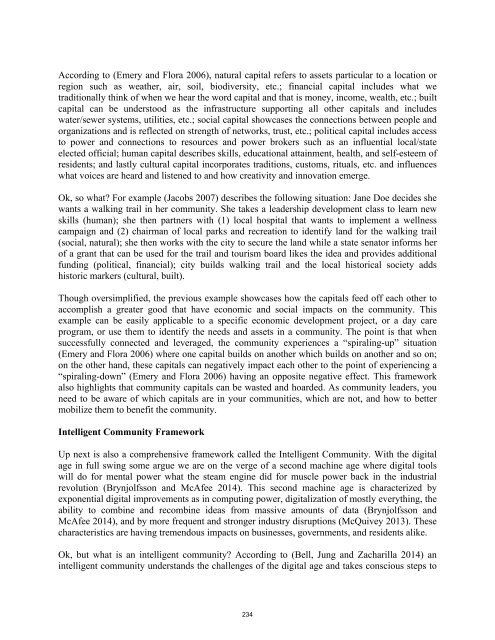in Mississippi
m2078-county-gov-ms
m2078-county-gov-ms
Create successful ePaper yourself
Turn your PDF publications into a flip-book with our unique Google optimized e-Paper software.
Accord<strong>in</strong>g to (Emery and Flora 2006), natural capital refers to assets particular to a location or<br />
region such as weather, air, soil, biodiversity, etc.; f<strong>in</strong>ancial capital <strong>in</strong>cludes what we<br />
traditionally th<strong>in</strong>k of when we hear the word capital and that is money, <strong>in</strong>come, wealth, etc.; built<br />
capital can be understood as the <strong>in</strong>frastructure support<strong>in</strong>g all other capitals and <strong>in</strong>cludes<br />
water/sewer systems, utilities, etc.; social capital showcases the connections between people and<br />
organizations and is reflected on strength of networks, trust, etc.; political capital <strong>in</strong>cludes access<br />
to power and connections to resources and power brokers such as an <strong>in</strong>fluential local/state<br />
elected official; human capital describes skills, educational atta<strong>in</strong>ment, health, and self-esteem of<br />
residents; and lastly cultural capital <strong>in</strong>corporates traditions, customs, rituals, etc. and <strong>in</strong>fluences<br />
what voices are heard and listened to and how creativity and <strong>in</strong>novation emerge.<br />
Ok, so what? For example (Jacobs 2007) describes the follow<strong>in</strong>g situation: Jane Doe decides she<br />
wants a walk<strong>in</strong>g trail <strong>in</strong> her community. She takes a leadership development class to learn new<br />
skills (human); she then partners with (1) local hospital that wants to implement a wellness<br />
campaign and (2) chairman of local parks and recreation to identify land for the walk<strong>in</strong>g trail<br />
(social, natural); she then works with the city to secure the land while a state senator <strong>in</strong>forms her<br />
of a grant that can be used for the trail and tourism board likes the idea and provides additional<br />
fund<strong>in</strong>g (political, f<strong>in</strong>ancial); city builds walk<strong>in</strong>g trail and the local historical society adds<br />
historic markers (cultural, built).<br />
Though oversimplified, the previous example showcases how the capitals feed off each other to<br />
accomplish a greater good that have economic and social impacts on the community. This<br />
example can be easily applicable to a specific economic development project, or a day care<br />
program, or use them to identify the needs and assets <strong>in</strong> a community. The po<strong>in</strong>t is that when<br />
successfully connected and leveraged, the community experiences a “spiral<strong>in</strong>g-up” situation<br />
(Emery and Flora 2006) where one capital builds on another which builds on another and so on;<br />
on the other hand, these capitals can negatively impact each other to the po<strong>in</strong>t of experienc<strong>in</strong>g a<br />
“spiral<strong>in</strong>g-down” (Emery and Flora 2006) hav<strong>in</strong>g an opposite negative effect. This framework<br />
also highlights that community capitals can be wasted and hoarded. As community leaders, you<br />
need to be aware of which capitals are <strong>in</strong> your communities, which are not, and how to better<br />
mobilize them to benefit the community.<br />
Intelligent Community Framework<br />
Up next is also a comprehensive framework called the Intelligent Community. With the digital<br />
age <strong>in</strong> full sw<strong>in</strong>g some argue we are on the verge of a second mach<strong>in</strong>e age where digital tools<br />
will do for mental power what the steam eng<strong>in</strong>e did for muscle power back <strong>in</strong> the <strong>in</strong>dustrial<br />
revolution (Brynjolfsson and McAfee 2014). This second mach<strong>in</strong>e age is characterized by<br />
exponential digital improvements as <strong>in</strong> comput<strong>in</strong>g power, digitalization of mostly everyth<strong>in</strong>g, the<br />
ability to comb<strong>in</strong>e and recomb<strong>in</strong>e ideas from massive amounts of data (Brynjolfsson and<br />
McAfee 2014), and by more frequent and stronger <strong>in</strong>dustry disruptions (McQuivey 2013). These<br />
characteristics are hav<strong>in</strong>g tremendous impacts on bus<strong>in</strong>esses, governments, and residents alike.<br />
Ok, but what is an <strong>in</strong>telligent community? Accord<strong>in</strong>g to (Bell, Jung and Zacharilla 2014) an<br />
<strong>in</strong>telligent community understands the challenges of the digital age and takes conscious steps to<br />
<br />
234


